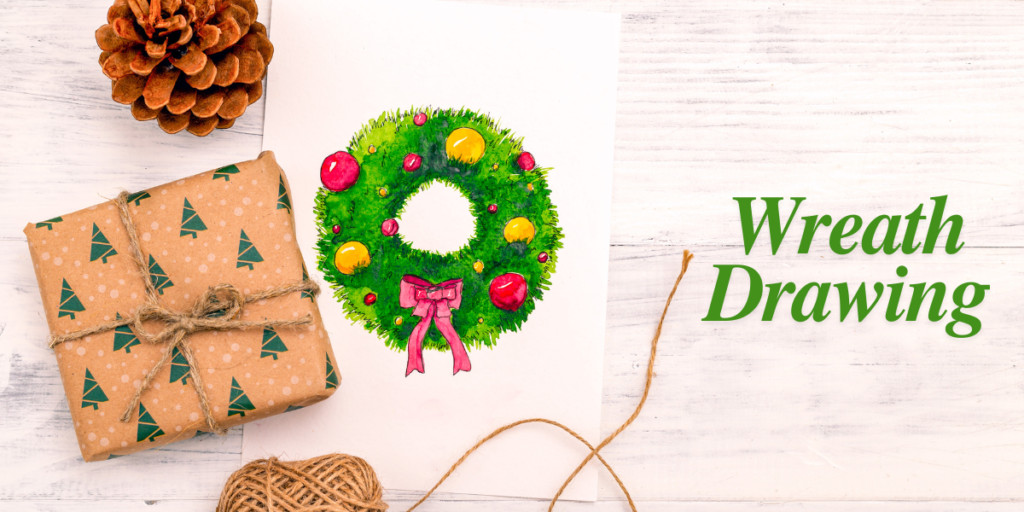Master the Art of Wreath Drawing: A Complete Guide for Artists
Wreaths, with their symbolic representation of unity, celebration, and nature, have been a cherished art form for centuries. Whether it’s for holiday decorations, a personal sketch, or intricate designs in a larger artwork, wreath drawing is an accessible yet deeply satisfying artistic endeavor.
This guide takes you step by step through the process of wreath drawing, from understanding the fundamentals to incorporating advanced techniques. Whether you’re new to the world of wreaths or an experienced artist seeking fresh ideas, this comprehensive tutorial will provide the insights you need.
Understanding Wreath Drawing

What Is a Wreath?
A wreath is a circular arrangement of natural or artificial materials, often used for decoration. Traditionally made from foliage, flowers, and branches, wreaths can be symbolic of seasonal changes, celebrations, or honor. In the realm of art, wreaths become an excellent subject for exploring circular composition, balance, and a variety of textures.
The Appeal of Wreath Drawing
Drawing wreaths is not just about capturing a decorative form; it’s about creating a harmonious piece of art that feels alive with movement and texture. Artists can convey different emotions and moods through the choice of elements used in the wreath, such as fresh spring flowers, rustic autumn leaves, or festive winter berries. For many, wreath drawing is a way to reconnect with nature, express creativity, and refine technical skills.
The Essential Tools for Wreath Drawing
Basic Tools for Beginners
- Pencils: Begin with an assortment of pencils (HB for light sketching, 2B or 4B for darker lines).
- Eraser: A kneaded eraser works best for precision and can help with softening lines.
- Paper: Choose smooth or lightly textured sketch paper for better control, especially if you plan to add details.
- Compass: A compass is helpful to draw perfect circular shapes, though free handing the circle can add a more natural feel to your wreath.
Advanced Tools for Detailed Work
- Fine Liners: Use fine-tipped pens or markers for inking delicate details like leaves, veins, and flower petals.
- Colored Pencils/Watercolors: These allow you to bring vibrancy and dimension to your wreath.
- Digital Tools: Digital platforms like Procreate, Adobe Illustrator, or other drawing apps can help create more intricate and customizable wreaths, allowing you to easily experiment with colors and compositions.
Step-by-Step Guide to Drawing a Wreath
Step 1: Sketch the Foundation
Begin by sketching a light circle, either with a compass or freehand. This circle will serve as the backbone of your wreath design. You can make the circle as large or small as you wish, depending on the size of the wreath you envision. For beginners, it’s helpful to draw a second, smaller circle inside to guide the placement of your elements.
Step 2: Choose Your Theme
Select a theme for your wreath. This step will determine the elements you include, as well as the overall aesthetic of your drawing. For example:
- Floral Wreath: Incorporate flowers like roses, lilies, or daisies for a fresh, natural look.
- Seasonal Wreath: Use holly, pine cones, and winter berries for a festive winter wreath or sunflowers and leaves for a summery vibe.
- Whimsical or Abstract Wreath: Create a wreath using unconventional materials or geometric patterns, focusing on form rather than realism.
Step 3: Add the Main Elements
Start by sketching the larger elements that will form the focal points of your wreath. This may include flowers, larger leaves, or other prominent objects like pinecones or ribbons. These elements should be spaced evenly around the circle to ensure balance and symmetry.
Step 4: Fill the Wreath with Smaller Details
Once you’ve placed the larger elements, begin filling in the gaps with smaller details such as buds, twigs, smaller leaves, berries, or vines. This is the stage where your wreath begins to feel full and lush. Keep an eye on the overall composition to ensure it remains balanced and cohesive.
Step 5: Refine the Sketch and Ink
Once you’re satisfied with your design, use a finer pencil or pen to go over the main lines of your wreath. Be mindful of the details and use a light hand when inking, especially when working with delicate elements. After the ink has dried completely, gently erase any leftover pencil lines.
Step 6: Add Color and Depth
If you’re adding color to your wreath, consider how light interacts with your elements. Use softer, lighter shades for areas that recede and darker hues for areas that are closer or in shadow. Blending colors and layering them will help create depth and make your wreath come alive.
Creative Ideas for Wreath Designs

Floral Wreaths
A floral wreath is the most traditional form, but you can experiment with different types of flowers and colors to create diverse styles. Consider using seasonal flowers or mixing flowers from different seasons to add unique elements to your design. Flowers like roses, sunflowers, and tulips convey a sense of beauty and renewal, while orchids, lilies, and peonies add elegance and sophistication.
Seasonal Wreaths
Creating wreaths for specific seasons allows you to incorporate natural elements that reflect the time of year.
- Winter: Pine boughs, holly leaves, and berries create a cozy, festive feel. Add in metallic details for a sparkling winter wreath.
- Spring: Think fresh, light colors like pastels and blossoms such as cherry blossoms, tulips, and daffodils.
- Autumn: Warm hues such as deep reds, oranges, and yellows dominate fall wreaths, paired with acorns, dried leaves, and branches.
Minimalist Wreaths
Minimalism is about simplicity and clean lines. Instead of using a wide array of elements, try limiting yourself to a single type of leaf, a few geometric shapes, or a simple wreath made of twigs. The beauty of minimalist wreaths lies in their understated elegance and the balance they achieve using very few components.
Advanced Techniques to Elevate Your Wreath Drawing
Layering and Depth
One of the most effective ways to add realism to your wreath drawing is by layering. By placing certain elements in the foreground and others in the background, you can create the illusion of depth. For example, you could have larger flowers at the forefront with smaller, less detailed leaves or buds in the background.
Texturing
Textures bring life to your wreath. Drawing the veins on leaves or the fine details of flower petals can make the wreath appear more lifelike. Use cross-hatching or stippling techniques to achieve fine textures.
Digital Techniques
For those working digitally, experimenting with layers can bring your wreath to the next level. Separate elements into layers (such as leaves, flowers, and background) for greater flexibility. Digital tools allow you to manipulate color, opacity, and texture with ease, enabling endless creative possibilities.
FAQs about Wreath Drawing
1. How do I create a wreath with a more natural feel?
For a more organic look, avoid perfect symmetry. Let the elements flow around the circle in a natural, asymmetrical pattern. Use curved lines for vines and twigs to create a more fluid design.
2. Can I draw a wreath without using a circle?
Absolutely! While circles are traditional, you can experiment with oval, square, or freeform shapes to create a more unique and dynamic wreath.
3. How can I make my wreath more detailed?
To enhance the detail in your wreath, focus on adding fine lines to elements like leaves and flowers, create texture through shading, and use small, delicate details like veins or individual flower petals.
4. What are the best colors for a wreath drawing?
The best colors depend on the season and theme. Soft pastels work well for spring wreaths, while deeper tones like burgundy and gold are great for autumn. For a more modern touch, experiment with bold and contrasting colors.
5. What is the best medium for wreath drawing?
Pencils, ink pens, and colored pencils are perfect for beginners. Watercolors, acrylics, or digital mediums offer more flexibility for those looking for a polished finish or vibrant color.
Conclusion
Drawing a wreath offers a blend of artistic challenge and creative freedom, making it a fulfilling project for artists of all levels. Whether you’re sketching a simple design or experimenting with intricate, detailed compositions, mastering wreath drawing adds a valuable tool to your artistic repertoire. Use this guide as a starting point, but remember: the most important part of any artistic process is the joy of creation.












Post Comment